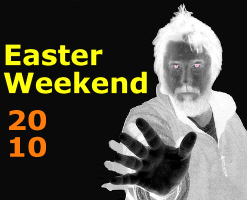
G’day and welcome to Partakers Christian Podcasts! Join us for uplifting Bible teaching, inspiring readings, heartfelt worship, powerful prayers, and fascinating church history. Whether you’re new to faith or growing deeper in your journey, we’re here to encourage and equip you. 🎧 Tune in, interact, and be inspired—wherever you are in the world.
Episodes

Friday Apr 02, 2010
Easter 2010 - Friday
Friday Apr 02, 2010
Friday Apr 02, 2010
Easter 2010 Easter Weekend Series
Friday - Jesus' Last Moments
Right mouse click here to save this Podcast as a MP3.
G'day and welcome to Partake! In the previous study of this Easter 2010 weekend series, we looked together at two events of Jesus' last night: the Lord's Supper and the Lord's Service. Tonight we are going to look together briefly at John 19, and talk a little bit about what happened to Jesus Christ - condemned, crucified, dead and buried.1. . Jesus was Condemned
So firstly lets look at Jesus' condemnation. Reading from John 19v1 to 16. 1Then Pilate took Jesus and had him flogged. 2The soldiers twisted together a crown of thorns and put it on his head. They clothed him in a purple robe 3and went up to him again and again, saying, "Hail, king of the Jews!" And they struck him in the face. 4Once more Pilate came out and said to the Jews, "Look, I am bringing him out to you to let you know that I find no basis for a charge against him." 5When Jesus came out wearing the crown of thorns and the purple robe, Pilate said to them, "Here is the man!" 6As soon as the chief priests and their officials saw him, they shouted, "Crucify! Crucify!" But Pilate answered, "You take him and crucify him. As for me, I find no basis for a charge against him." 7The Jews insisted, "We have a law, and according to that law he must die, because he claimed to be the Son of God." 8When Pilate heard this, he was even more afraid, 9and he went back inside the palace. "Where do you come from?" he asked Jesus, but Jesus gave him no answer. 10"Do you refuse to speak to me?" Pilate said. "Don't you realize I have power either to free you or to crucify you?" 11Jesus answered, "You would have no power over me if it were not given to you from above. Therefore the one who handed me over to you is guilty of a greater sin." 12From then on, Pilate tried to set Jesus free, but the Jews kept shouting, "If you let this man go, you are no friend of Caesar. Anyone who claims to be a king opposes Caesar." 13When Pilate heard this, he brought Jesus out and sat down on the judge's seat at a place known as the Stone Pavement (which in Aramaic is Gabbatha). 14It was the day of Preparation of Passover Week, about the sixth hour. "Here is your king," Pilate said to the Jews. 15But they shouted, "Take him away! Take him away! Crucify him!" "Shall I crucify your king?" Pilate asked. "We have no king but Caesar," the chief priests answered. 16Finally Pilate handed him over to them to be crucified. Pilate was the Roman Governor of Judea. As we have read, it was he that made the decision and gave the order for Jesus to be crucified. Pilate gave in and permitted the flogging and mockery in the hope of shaming Jesus' accusers (John 19vs. 1-3). Pilate affirmed Jesus' innocence after the scourging (John 19v4). Jesus' refusal to answer stung Pilate into reminding Jesus of his Roman authority (John 19v10). Jesus, however, corrected Pilate's idea of authority and told him that although Pilate may have power on earth, his power did not reach beyond earth (John 19v11). Jesus knew that his work of bring people back to God in a loving relationship did not rest on the actions of a mere Roman governor. Pilate was more concerned with his own position than he was for justice. In all this, we see Jesus as the true Passover lamb.2. Jesus was Crucified
So Jesus was condemned to die. Now lets look at John 19v17-27 and Jesus' crucifixion. 17Carrying his own cross, he went out to the place of the Skull (which in Aramaic is called Golgotha). 18Here they crucified him, and with him two others-one on each side and Jesus in the middle. 19Pilate had a notice prepared and fastened to the cross. It read:|sc JESUS OF NAZARETH, THE KING OF THE JEWS. 20Many of the Jews read this sign, for the place where Jesus was crucified was near the city, and the sign was written in Aramaic, Latin and Greek. 21The chief priests of the Jews protested to Pilate, "Do not write 'The King of the Jews,' but that this man claimed to be king of the Jews." 22Pilate answered, "What I have written, I have written." 23When the soldiers crucified Jesus, they took his clothes, dividing them into four shares, one for each of them, with the undergarment remaining. This garment was seamless, woven in one piece from top to bottom. 24"Let's not tear it," they said to one another. "Let's decide by lot who will get it." This happened that the scripture might be fulfilled which said, "They divided my garments among them and cast lots for my clothing." So this is what the soldiers did. 25Near the cross of Jesus stood his mother, his mother's sister, Mary the wife of Clopas, and Mary Magdalene. 26When Jesus saw his mother there, and the disciple whom he loved standing nearby, he said to his mother, "Dear woman, here is your son," 27and to the disciple, "Here is your mother." From that time on, this disciple took her into his home. Jesus bearing his own cross was killed as a common criminal (John 19v17). We read, that Pilate was responsible for fixing the sign "The King of the Jews" (John 19v21-22). The clothes of condemned prisoners were given to soldiers on duty (John 19v23). Even when he himself was in agony, Jesus showed concern for his mother, committing her to the Apostle John (John 19vs.26-27). The crucifixion site "was purposely chosen to be outside the city walls because the Law forbade such within the city walls... for sanitary reasons... the crucified body was sometimes left to rot on the cross and serve as a disgrace, a convincing warning and deterrent to passers-by." Sometimes, the subject was eaten while alive and still on the cross by wild beasts. Jesus face was beaten beyond recognition and the scourging reduced his flesh to something like raw hamburger mince. The whips used has pieces of glass and rocks stuck to the cord so as to inflict as much damage as possible. He had a crown of thorns pushed into his scalp.3. Jesus died
Having been condemned and crucified, Jesus finally dies. Lets look together at John 19v28-37. 28Later, knowing that all was now completed, and so that the Scripture would be fulfilled, Jesus said, "I am thirsty." 29A jar of wine vinegar was there, so they soaked a sponge in it, put the sponge on a stalk of the hyssop plant, and lifted it to Jesus' lips. 30When he had received the drink, Jesus said, "It is finished." With that, he bowed his head and gave up his spirit. 31Now it was the day of Preparation, and the next day was to be a special Sabbath. Because the Jews did not want the bodies left on the crosses during the Sabbath, they asked Pilate to have the legs broken and the bodies taken down. 32The soldiers therefore came and broke the legs of the first man who had been crucified with Jesus, and then those of the other. 33But when they came to Jesus and found that he was already dead, they did not break his legs. 34Instead, one of the soldiers pierced Jesus' side with a spear, bringing a sudden flow of blood and water. 35The man who saw it has given testimony, and his testimony is true. He knows that he tells the truth, and he testifies so that you also may believe. 36These things happened so that the scripture would be fulfilled: "Not one of his bones will be broken," 37and, as another scripture says, "They will look on the one they have pierced." In Jesus' final moments he uttered "I am thirsty." (John 19v28) and "It is finished." (John 19v30). The desire of the Jews (John 19v32) to fulfil their rituals was important because the Sabbath fell within the Passover festival. The breaking of legs (John 19vs.32-33) sped up the process of death. The piercing of Jesus' side, and the flow of blood and water proved Jesus was really dead (John 19v34). So Jesus was condemned, crucified and died. So what? What does that mean for us and for humanity? All human beings, in their natural state, are born sinners and have rebelled against God (Romans 3v23). However, because of Jesus' death on the cross God offers forgiveness (Ephesians 1v7), Peace (Romans 5v1) and reconciliation with God, so that we are no longer His enemies (2 Corinthians 5v19). Through the cross, and only through the cross, we are made just before God (Romans 3v24-26), it cleanses us from sin (1 John 1v7) and makes us right before Almighty God (2 Corinthians 5v21). Because of the Cross, we have direct access to God (Ephesians 2v18) and Jesus Christ intercedes for us (Hebrews 2v17-18). Because of Jesus Christ's death on a Roman cross, all those who follow Him have freedom from the power of slavery to sin (Galatians 5v1) and freedom from the power of the devil (Hebrews 2v14). None of the above things are true if we do not follow Jesus. At the cross, Jesus' mission is accomplished. At the cross, this God-man, Jesus Christ paid the penalty for all sin of all time, so that people can have the opportunity to be restored into relationship with God. Some people say that Jesus didn't die on the cross, but rather somebody was made to be His substitute. But this is a lie of the devil. Nobody could have been a substitute or the Jewish leaders would have said so when the rumours of Jesus' resurrection began to circulate. The Romans kept strict discipline and regimen and nobody would have been able to get in amongst the Roman soldiers and somehow substitute themselves for Jesus. Yes, somebody else carried the cross for Him, but nobody but Jesus was nailed to that cross. Jesus died on that cross and not some substitute.4. Jesus was Buried
38Later, Joseph of Arimathea asked Pilate for the body of Jesus. Now Joseph was a disciple of Jesus, but secretly because he feared the Jews. With Pilate's permission, he came and took the body away. 39He was accompanied by Nicodemus, the man who earlier had visited Jesus at night. Nicodemus brought a mixture of myrrh and aloes, about seventy-five pounds. 40Taking Jesus' body, the two of them wrapped it, with the spices, in strips of linen. This was in accordance with Jewish burial customs. 41At the place where Jesus was crucified, there was a garden, and in the garden a new tomb, in which no one had ever been laid. 42Because it was the Jewish day of Preparation and since the tomb was nearby, they laid Jesus there. Joseph of Arimithea and Nicodemus buried Jesus. The significance of "in which no-one had ever been laid" (John 19v41) is to demonstrate that the body of Jesus at no point came into contact with the decay of a dead body. But his burial is not the end of the story. In the next of our series, Easter Saturday, we will look together at just why Jesus had to die - and the underlying problem. Then we will look at how his death is the solution. We will also look briefly at the themes of substitution, propitiation, redemption and how his death is the complete victory over sin, death and the devil. Then on Sunday, we will look at the Resurrection!Right mouse click here to save this Podcast as a MP3.
 If you find these resources helpful to you, please do prayerfully consider making a donation. You can support via PayPal, the universal and most secure way to donate money online. You do not need to be a member of Paypal to use their facilities and all major credit cards are accepted. Thank you
If you find these resources helpful to you, please do prayerfully consider making a donation. You can support via PayPal, the universal and most secure way to donate money online. You do not need to be a member of Paypal to use their facilities and all major credit cards are accepted. Thank you
Click on the appropriate link to subscribe to this website


Version: 20241125


No comments yet. Be the first to say something!